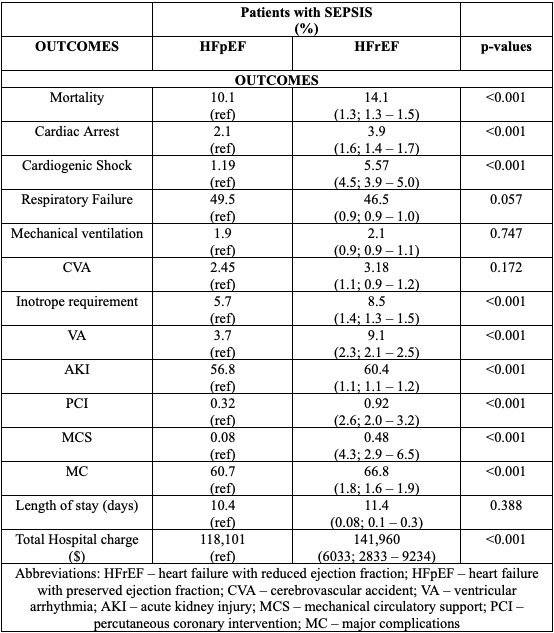Background: The diagnosis of sepsis is often associated with high rates of morbidity and mortality. When it occurs in patients with Heart failure (HF), those rates increase dramatically. This study focuses on the differences in the outcomes in septic patients with Heart Failure with preserved Ejection Fraction (HFpEF) versus patients with Heart Failure with reduced Ejection Fraction (HFrEF) as well as the sex-based differences in both cohorts.
Methods: This was a retrospective study using patient records from the 2016-2020 National In-patient Sample. We identified patients who were admitted for sepsis with a history of HFpEF and HFrEF. We used univariate and multivariate logistic regression for analysis.
Results: This study included about 2,314,299 with sepsis. Of these, about 153,135 had HFrEF, and 243,380 had HFpEF. We noted a male predominance in HFrEF as opposed to our population with HFpEF. In comparison to the HFpEF cohort, our septic group with HFrEF had higher rates of mortality (aOR: 1.4, CI 1.3 – 1.46, p>0.001), cardiogenic shock (aOR: 4.5, CI 3.96 – 5.0, p>0.001), cardiac arrests (p>0.001), ventricular arrhythmias. We also observed a higher hospital cost incurred by our septic population with HFrEF ($141,960 vs $118,101, p< 0.001). Our male cohort had worse outcomes in the subset of HFrEF as well as HFpEF though our female cohort in the HFrEF group had higher rates of CVA.
Conclusions: When admitted for the treatment of sepsis, patients with HFrEF had worse outcomes than patients with HFpEF. Male patients have worse outcomes in the setting of sepsis and HF.

